St. Brigid’s Well — A Sacred Spring of Faith and Folklore

On the winding road that runs west out of Liscannor, a simple stone grotto marks one of Ireland’s most venerated holy wells. Pilgrims and passersby alike know it by its quiet power: St. Brigid’s Well, a place where centuries of devotion have left ribbons, rosaries, medals, photographs, and whispered prayers woven into its walls.
The well is dedicated to Brigid of Kildare, Ireland’s most beloved female saint, whose life and legends span the thin line between Christian faith and pre-Christian lore. Born in the 5th century, Brigid is remembered as an abbess, a healer, and a woman of miracles — but her presence stretches deeper still. Scholars tell us that before she was canonized, she may have been worshipped as a Celtic goddess of fertility, poetry, and fire. At wells and springs across Ireland, the sacredness of Brigid never faded, only transformed, merging the goddess and the saint into a figure of enduring reverence.
A place of living ritual
St. Brigid’s Well in Liscannor is no museum piece. It is a living site of pilgrimage where old traditions continue. Visitors perform “the rounds” — a ritual walk of prayer circling the grotto and spring. They pause to tie clooties — ribbons, strips of fabric, or personal tokens — to branches and railings, each representing a hope, a cure, or a remembrance. Candles burn in the dim grotto, their smoke blackening the stone ceiling, their wax pooling like stalactites — each flame a plea or a thanksgiving.
At the heart of it, water flows. Pilgrims dip their fingers, cross themselves, or take a sip, trusting in its reputed healing powers. For generations, parents have brought sick children here, farmers have prayed for healthy livestock, and the weary have sought strength from Brigid’s spring.
Patterns and pilgrimage
Every year on February 1st, St. Brigid’s Day, and again on August 15th, the Feast of the Assumption, the well becomes the centre of a local pattern day — a gathering where faith and folklore meet. Families, neighbours, and travellers walk the rounds together, pray aloud, sing hymns, and share food afterwards. Once, pattern days were infamous for merriment as well as devotion, with music, dancing, and even matchmaking at the edges of the holy site. Today, the atmosphere is quieter, but the tradition endures — a communal act of remembering and renewing.
Stories in stone
What makes St. Brigid’s Well especially moving is the way it holds layers of memory. The grotto walls are crowded with tokens: photographs of loved ones lost, scapulars, locks of hair, written notes, Mass cards, and crosses woven from rushes. Step inside and you feel surrounded not only by stone, but by a tapestry of lives and prayers. Every object left here tells a story — of grief, gratitude, hope, or desperation. Together they form a kind of living archive of Clare’s people, their faith etched not in parchment but in offerings.
Why it matters
For Liscannor, St. Brigid’s Well is more than a landmark. It is a reminder that the village is part of a much older spiritual landscape, one where Christianity blended with Celtic tradition, and where the act of gathering at water has always bound communities together. For visitors, it is a place of quiet awe — humbler than the cliffs, but just as profound in its way. To kneel at the well, or simply to pause in its candlelit hush, is to touch something that has endured for centuries: the human need for healing, hope, and connection to forces larger than ourselves.
Related Folklore
Other Heritage sites

Hag’s Head & the Moher Signal Tower - A Story Told by Stone
At the southern end of the Cliffs of Moher lies Hag’s Head, a rugged headland where land gives way to legend. Named for the profile of the witch Mal, whose tragic story is etched into the stone, this is a place of many layers. It was once a prehistoric clifftop fortress and later the site of a Napoleonic-era signal tower, which still stands against the sky. Today, a walk here reveals not only these echoes of the past but also one of the most breathtaking views of the entire cliff coastline.

Liscannor Castle Ruins - Stronghold of Stone and Shadow
The ivy-clad ruin of Liscannor Castle stands as a proud reminder of the village’s medieval past as a Gaelic stronghold. Built in the 16th century by the powerful O’Connor clan and later controlled by the O’Briens, this six-storey tower house was both a fortress against rivals and a home filled with life. Though abandoned for centuries, its broken tower remains a beloved landmark, a romantic silhouette against the Atlantic sky that holds the stories of chieftains, feuds, and the families who once ruled at the edge of the sea.
Ready to Explore Liscannor?
Questions? Need directions or recommendations? We’re here to help you make the most of your time in Liscannor.